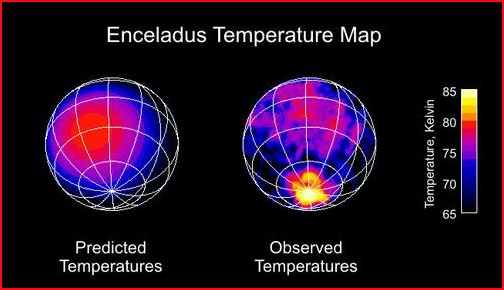
home •
about •
essential guide •
picture of the day •
thunderblogs •
news •
multimedia •
predictions •
products •
get involved •
contact

Credit: Courtesy NASA/JPL-Caltech
pic of the day
archive
subject index
abstract
archive
Links:
Society for
Interdisciplinary
Studies
Aug 09, 2005
The Hot Poles of Enceladus
The unexpected hot spot around Enceladus’ south pole is another indication of electric currents coursing through Saturn’s moon and connected with the electric circuits that compose Saturn’s plasma sheath.
The NASA press release reports that this image “startled” scientists. The hot spot around Enceladus’ south pole is “very difficult to explain if sunlight is the only energy source heating the surface.” The only other likely heat source available to conventional theorists is internal heat, but they are “unsure how the internal heat reaches the surface.”
Close-up images reveal a series of somewhat parallel fractures that are the centers of the heat. NASA scientists speculate that internal heat escapes through these fractures and evaporates the ice along them, thereby generating Enceladus’ thin atmosphere of water vapor, which seems to be concentrated over the south pole. Water escaping from the atmosphere may be the source of the icy material in Saturn’s E ring, the largest ring, in which Enceladus orbits.
The fractures are only 1 to 2 kilometers wide but extend over 100 kilometers in length. Proponents of the Electric Universe recognize this form as the typical electrically excavated rille. They also notice the correspondence of Enceladus’ hot pole with hot spots around the poles of other planets and moons. The electrical circuits in Saturn’s plasma sheath will include a “neutral sheet” and ring currents (plasma toroids) in the plane of the rings, and Enceladus orbits within those currents.
In this respect, Enceladus is similar to Io, orbiting within an equatorial toroid around Jupiter and connected to Jupiter’s auroral circuit by a polar flux tube. As Peratt and Dessler have shown in Filamentation of Volcanic Plumes on the Jovian Satellite Io, A. L. Peratt and A. J. Dessler, Astrophys. Space Sci. 144, pp. 451-461, 1988 (1M)., Io’s “volcanoes” are “plasma gun” discharges in the electric circuits flowing through and around Io.
In the electric view, the warm rilles and hot pole are electrically heated. The water vapor from the rilles is being electrically “machined” from them. A similar process should be occurring at the north pole, where the electric current flowing through Enceladus returns to Saturn’s sheath circuit.
NASA scientists have noticed the “bending” of Saturn’s magnetic field around Enceladus “due to electric currents generated by the interaction of atmospheric particles and the magnetosphere of Saturn.” But their blind spot with regard to plasma behavior leads them to insist that the electric currents “don’t do anything.”
The past century of plasma research demonstrates just the opposite. Experimental scientists from Birkeland to Alfven confirm the insight of Heraclitus in the Fifth Century BCE: It is the thunderbolt that steers the universe.
EXECUTIVE EDITORS:
David Talbott, Wallace Thornhill
MANAGING EDITOR:
Mel Acheson
CONTRIBUTING EDITORS: Michael Armstrong, Dwardu Cardona, Ev Cochrane,
C.J. Ransom, Don Scott, Rens van der Sluijs, Ian Tresman
WEBMASTER: Michael Armstrong
Copyright 2005: thunderbolts.info